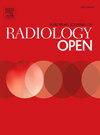Clinical and MRI variables associated with close or positive margins during breast-conserving surgery using MRI projection mapping in breast carcinoma with nonmass enhancement
IF 2.9
Q3 RADIOLOGY, NUCLEAR MEDICINE & MEDICAL IMAGING
引用次数: 0
Abstract
Purpose
To evaluate the utility of a magnetic resonance imaging (MRI) projection mapping system (PMS) for determining the resection lines during breast-conserving surgery (BCS) in patients with breast cancer presenting with nonmass enhancement (NME) and identify the clinical or MRI variables associated with close or positive margins.
Materials and methods
Forty-one patients with breast cancer exhibiting NME were enrolled. In the operating room, a maximum intensity projection image generated from supine MRI was projected onto the breast using a PMS, which employed a structured light method to measure the surface of the breast. Cancer contours delineated on the MRI-PMS, with an additional safety margin, served as the resection lines for cylindrical BCS. Margins were pathologically categorized as negative (> 2 mm), close (≤ 2 mm), or positive. The association between margin status and clinical or MRI variables was analyzed.
Results
Surgical margins were negative in 24 patients (58.5 %), close in 15 (36.6 %), and positive in 2 (4.9 %). There were significant differences in the maximum diameter of nonmass components (NMCs) shown by pathology, that of NME on MRI, and the discrepancy between the two diameters between patients with negative margin and those with close or positive margin (< 0.05 for all). Receiver operating characteristics revealed that threshold of 40 mm for NMEs provided high specificity of 91.7 %.
Conclusion
The MRI-PMS led to a low rate of positive margins during BCS in patients with breast cancer with NMEs. Large NMCs and NMEs are associated with positive or close margin.
在非肿块增强的乳腺癌保乳手术中,MRI投影成像与边缘闭合或阳性相关的临床和MRI变量
目的评估磁共振成像(MRI)投影成像系统(PMS)在乳腺癌保乳手术(BCS)期间确定非肿块增强(NME)患者切除线的效用,并确定与边缘闭合或阳性相关的临床或MRI变量。材料与方法入选41例表现为NME的乳腺癌患者。在手术室中,使用PMS将仰卧位MRI产生的最大强度投影图像投影到乳房上,PMS采用结构光法测量乳房表面。在MRI-PMS上划定的肿瘤轮廓,具有额外的安全裕度,作为圆柱形BCS的切除线。切缘病理分类为阴性(≤2 mm)、接近(≤2 mm)或阳性。分析了切缘状态与临床或MRI变量之间的关系。结果手术切缘阴性24例(58.5% %),闭合15例(36.6 %),阳性2例(4.9 %)。病理显示的非肿块成分(NMCs)最大直径与MRI显示的NME最大直径、切缘阴性患者与切缘相近或阳性患者的最大直径差异均有统计学意义(均为0.05)。接受者工作特征显示,NMEs的阈值为40 mm,特异性为91.7 %。结论MRI-PMS可导致合并NMEs的乳腺癌患者BCS阳性切缘率低。大型nmc和NMEs与正边际或近边际相关。
本文章由计算机程序翻译,如有差异,请以英文原文为准。
求助全文
约1分钟内获得全文
求助全文
来源期刊

European Journal of Radiology Open
Medicine-Radiology, Nuclear Medicine and Imaging
CiteScore
4.10
自引率
5.00%
发文量
55
审稿时长
51 days
 求助内容:
求助内容: 应助结果提醒方式:
应助结果提醒方式:


